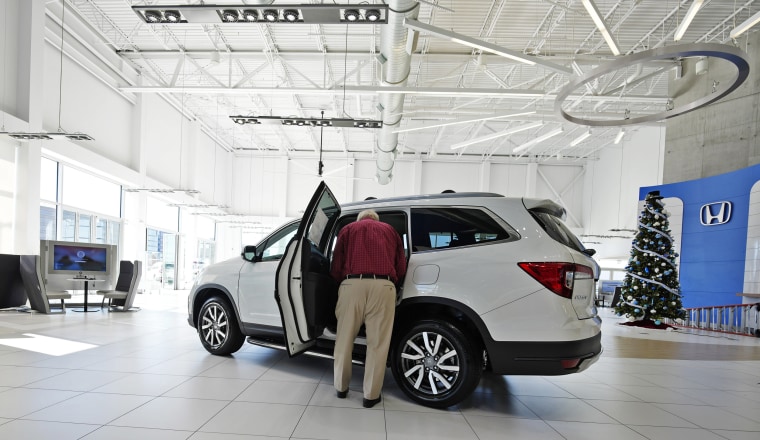What was supposed to be a very good year for the U.S. auto industry didn’t turn out that way in 2021, as automakers battled semiconductor shortages and other problems that repeatedly shut down factories and left showrooms bare. For consumers, that meant record prices and less choice.
Those hoping the situation will improve in 2022 can think again. At best, industry analysts foresee a modest upturn in sales, and possibly another sharp downturn, while car buyers can expect even more price hikes and more dealer shortages.
“Based on what we know today, it will be a challenge to match last year’s sales,” said Dave Gardner, executive vice president of national operations for American Honda.
Just as the economy began to rebound in late 2020, with car sales surging, the industry was hit with a shortage of crucial semiconductor chips, resulting in on-and-off production cuts for all of 2021.
This year, Cox Automotive does see a modest industry rebound, to about 16 million vehicles from 14.9 million last year. IHS Markit is a bit more cautious, at around 15.5 million. But those figures are still well below what was seen prior to Covid. In 2019, Americans bought 17.1 million new cars, trucks and crossovers.
Meanwhile, a new study from Bank of America’s auto research team warns of sharp “demand destruction.”
At the start of this year, Honda dealers had 20,000 vehicles on their lots. A year ago, that number was around 320,000.
“In our view, the single biggest risk to our volume forecasts is that the broader economic environment and health/confidence of the consumer remains very much unclear,” BoA analysts wrote in a research note.
On the whole, the chip shortage seems to be coming under control. But there are still widespread worries about other supply chain disruptions impacting rubber, plastics and foams and even steel. Wall Street has underscored concerns about rising interest rates and inflation.
Ironically, unless buyers do get scared off by inflation and rising interest rates, “demand will significantly outstrip supply,” said Stephanie Brinley, principal analyst for automotive at IHS Markit, noting that the ongoing sales slump is completely different from what was seen during the Great Recession and earlier market declines.
This downturn is all about supply, Brinley said. If anything, pent-up demand totals as much as 3 million vehicles — which means millions of motorists would head back into the market if they could find the vehicles they want.
Honda’s situation underscores the problem. At the start of this year, the company's U.S. dealers had barely 20,000 vehicles on their lots. A year ago, that number was around 320,000. According to research firm Motor Intelligence, car dealers ended 2021 with 1.04 million vehicles in inventory, compared to 3.4 million two years earlier.
If the industry can sidestep new shortages, manufacturers will put pedal to metal, running as much overtime as possible, but Gardner said Honda doesn’t expect to catch up and will continue facing weak inventories. Brinley said the same goes for other automakers.
The situation is radically shifting the normal business model. Americans traditionally drive up to showrooms expecting to trade in and drive home with a new vehicle. Now, most buyers can expect to wait, sometime as long as two months, to take delivery.
There is an upside. For consumers, that means a shift to online buying — and the ability to customize a vehicle, rather than settle for whatever is on the lot. For automakers and dealers, lower inventories mean lower holding costs and they can more closely adjust production to demand.
Automakers have also halved the incentives they traditionally offer — to around $1,900 for the typical vehicle in December, according to industry data. But, for consumers, that has contributed to a rapid run-up in pricing. New car prices surged to a record average of $47,077 during December, according to a report by Kelley Blue Book released last week, more than $10,000 above what the typical motorist paid pre-Covid.
New car prices surged to a record average of $47,077 last month — $10,000 more than before Covid hit.
“Think back two years ago,” Gardner said. “When did you ever hear of cars selling off the MSRP [the manufacturer’s suggested retail price]? Now, that’s the start of the conversation.”Consumers have helped drive up prices by switching from sedans and coupes to more expensive SUVs and CUVs, and then loading up on options, Brinley noted.
But what really concerns analysts and industry planners are so-called ADMs, or the “additional dealer markups” many dealers are tacking on, especially for popular products. Ford, in particular, is worried about retailers marking up the F-150 Lightning, set to go into production in June. Some early reservation holders reportedly have backed out after facing additional fees topping $10,000.
Franchise laws limit the ability of automakers to influence dealer pricing, though automakers could potentially penalize dealers who get greedy by limiting what is expected to be early, limited allocations of the electric truck.
As dealer inventories begin their slow rebound, the past year’s price surge may not happen “as rapidly as in the past few months,” according to the BoA study. However, car buyers should expect the upward trend to continue well into 2022.
